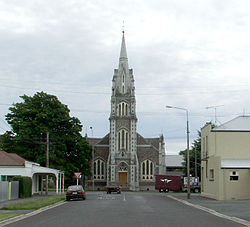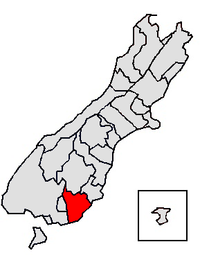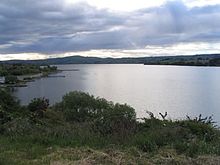Clutha District
Clutha District | |
|---|---|
 Tokomairiro Presbyterian Church, Milton | |
 | |
| Coordinates:46°05′S169°33′E/ 46.09°S 169.55°E | |
| Country | New Zealand |
| Region | Otago |
| Communities |
|
| Wards |
|
| Seat | Balclutha |
| Government | |
| •Mayor | Bryan Cadogan |
| • Deputy Mayor | Ken Payne[1] |
| •Territorial authority | Clutha District Council |
| Area | |
| • Total | 6,307.32 km2(2,435.27 sq mi) |
| Population (June 2023)[3] | |
| • Total | 18,900 |
| • Density | 3.0/km2(7.8/sq mi) |
| Time zone | UTC+12(NZST) |
| • Summer (DST) | UTC+13(NZDT) |
| Postcode(s) | |
| Area code | 03 |
| Website | www |
Clutha Districtis alocal government districtof southernNew Zealand,with its headquarters in theOtagotown ofBalclutha.Clutha District has a land area of 6,334.47 km2(2,445.75 sq mi) and an estimated population of 18,900 as of June 2023. Clutha District occupies the majority of the geographical area known asSouth Otago.
Geography
[edit]
The geography of the Clutha District is dominated by the valley of theClutha River,which flows southeast from the lakes ofCentral Otago,bisecting the Clutha District and reaching thePacific Oceanvia two river mouths, one of which is not far fromKaitangata,the other is closer to Kaka Point. The two branches of the river (the Matau and the Kouau) form the island ofInch Clutha.To the south of this is the rough bush country ofthe Catlins,with its forests and rugged coastline. To the north of the Clutha valley is mainly rolling hill country, with the plain of theTokomairaro Riverto the northeast, along withLake WaiholaandLake Waipori,which are part of the catchment of theTaieri River.TheWaipori River,the Taieri's largest tributary, forms the northeastern border of Clutha District.

Administration
[edit]Clutha District is under the local body administration of the Clutha District Council, based in Balclutha. It is administered at a regional level by theOtago Regional Council,based in Dunedin.
Clutha District was formerly composed of three separate counties (Clutha, Bruce, and Tuapeka), and two boroughs (Balclutha andMilton). These were amalgamated into one district authority in 1989 as part of a nationwide reorganisation of local government.
Bruce, an area surrounding Milton, and including the Tokomairaro Plains, had an area of 1,357 km². It included the townships ofWaihola,MilburnandWaitahuna.Clutha, which included the delta of the Clutha River and extended down the Catlins coast, had an area of 2,664.5 km². It included the townships ofKaitangata,Stirling,Owaka,andBenhar.The remaining area, Tuapeka, was centred onLawrence,and included the inland valleys of the Clutha River and its tributaries thePomahaka RiverandTuapeka River.It had an area of 2,323 km².
The current mayor isBryan Cadogan,who defeated incumbent mayor Juno Hayes in the2010 local body elections,and retained the mayoralty in the2013,2016,2019and2022 elections.The current deputy mayor is Ken Payne.[1]
Demographics
[edit]The most populous town in Clutha District isBalclutha,which lies 81 km south ofDunedinby road. Balclutha's population was 4,340 in June 2023. Other towns areMilton(pop. 2,240),Kaitangata,Tapanui,Lawrence,Owaka,Stirling,Clinton,Kaka Point,andBenhar.
Clutha District covers 6,307.32 km2(2,435.27 sq mi)[2]and had a population of 18,900 as of June 2023,[3]with a population density of 3.0 people per km2.
| Ethnicity | Population |
|---|---|
| New Zealand European | 15,912
|
| Māori | 2,538
|
| Pasifika | 675
|
| Asian | 828
|
| MELAA | 102
|
| Other | 309
|
| Year | Pop. | ±% p.a. |
|---|---|---|
| 2006 | 16,839 | — |
| 2013 | 16,890 | +0.04% |
| 2018 | 17,667 | +0.90% |
| 2023 | 18,315 | +0.72% |
| Source:[4][5] | ||
Clutha District had a population of 18,315 in the2023 New Zealand census,an increase of 648 people (3.7%) since the2018 census,and an increase of 1,425 people (8.4%) since the2013 census.There were 8,955 dwellings. The median age was 42.7 years (compared with 38.1 years nationally). There were 3,402 people (18.6%) aged under 15 years, 2,943 (16.1%) aged 15 to 29, 8,436 (46.1%) aged 30 to 64, and 3,528 (19.3%) aged 65 or older.[5]
Ethnicities were 86.9% European/Pākehā,13.9%Māori,3.7%Pasifika,4.5%Asian,0.6% Middle Eastern, Latin American and African New Zealanders, and 1.7% other. People may identify with more than one ethnicity.[5]
Clutha District had a population of 17,667 at the2018 New Zealand census.There were 7,020 households, comprising 9,195 males and 8,472 females, giving a sex ratio of 1.09 males per female.
The percentage of people born overseas was 11.3, compared with 27.1% nationally.
Although some people chose not to answer the census's question about religious affiliation, 54.7% had no religion, 34.3% wereChristian,0.4% hadMāori religious beliefs,0.3% wereHindu,0.4% wereMuslim,0.7% wereBuddhistand 1.3% had other religions.
Of those at least 15 years old, 1,611 (11.3%) people had a bachelor's or higher degree, and 3,822 (26.8%) people had no formal qualifications. The median income was $30,900, compared with $31,800 nationally. 1,620 people (11.4%) earned over $70,000 compared to 17.2% nationally. The employment status of those at least 15 was that 7,539 (52.9%) people were employed full-time, 2,235 (15.7%) were part-time, and 393 (2.8%) were unemployed.[4]
| Name | Area (km2) | Population | Density (per km2) | Households | Median age | Median income |
|---|---|---|---|---|---|---|
| West OtagoWard | 1,374.66 | 2,289 | 1.67 | 909 | 40.1 years | $35,400 |
| ClintonWard | 839.70 | 1,230 | 1.46 | 465 | 33.8 years | $35,200 |
| Lawrence-TuapekaWard | 1,277.63 | 1,155 | 0.90 | 513 | 46.6 years | $27,300 |
| Balclutha Ward | 124.68 | 5,229 | 41.94 | 2,151 | 44.8 years | $30,300 |
| CatlinsWard | 1,072.98 | 1,032 | 0.96 | 453 | 49.3 years | $29,300 |
| BruceWard | 777.38 | 4,407 | 5.67 | 1,638 | 42.9 years | $27,700 |
| Kaitangata-MatauWard | 163.68 | 1,092 | 6.67 | 441 | 40.4 years | $31,000 |
| Clutha ValleyWard | 703.77 | 1,233 | 1.75 | 450 | 37.0 years | $40,200 |
| New Zealand | 37.4 years | $31,800 |
References
[edit]- ^ab"Mayor and Councillors".www.cluthadc.govt.nz.Clutha District Council.Retrieved19 April2024.
- ^ab"ArcGIS Web Application".statsnz.maps.arcgis.com.Retrieved29 February2024.
- ^ab"Subnational population estimates (RC, SA2), by age and sex, at 30 June 1996-2023 (2023 boundaries)".Statistics New Zealand.Retrieved25 October2023.(regional councils);"Subnational population estimates (TA, SA2), by age and sex, at 30 June 1996-2023 (2023 boundaries)".Statistics New Zealand.Retrieved25 October2023.(territorial authorities);"Subnational population estimates (urban rural), by age and sex, at 30 June 1996-2023 (2023 boundaries)".Statistics New Zealand.Retrieved25 October2023.(urban areas)
- ^ab"Statistical area 1 dataset for 2018 Census".Statistics New Zealand. March 2020. Clutha District (072).2018 Census place summary: Clutha District
- ^abc"2023 Census national and subnational usually resident population counts and dwelling counts"(Microsoft Excel).Stats NZ - Tatauranga Aotearoa.Retrieved29 May2024.
